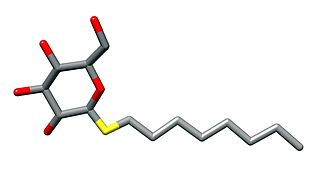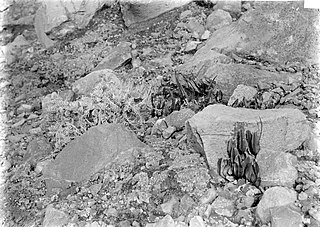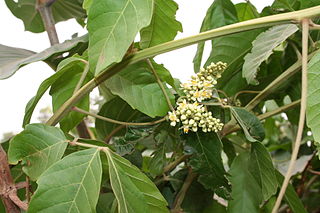
Acanthaceae is a family of dicotyledonous flowering plants containing almost 250 genera and about 2500 species. Most are tropical herbs, shrubs, or twining vines; some are epiphytes. Only a few species are distributed in temperate regions. The four main centres of distribution are Indonesia and Malaysia, Africa, Brazil, and Central America. Representatives of the family can be found in nearly every habitat, including dense or open forests, scrublands, wet fields and valleys, sea coast and marine areas, swamps, and mangrove forests.

n-Octyl β-d-thioglucopyranoside is a mild nonionic detergent that is used for cell lysis or to solubilise membrane proteins without denaturing them. This is particularly of use in order to crystallise them or to reconstitute them into lipid bilayers. It has a critical micelle concentration of 9 mM.

Umbelliferone, also known as 7-hydroxycoumarin, hydrangine, skimmetine, and beta-umbelliferone, is a natural product of the coumarin family.

Acanthus is a genus of about 30 species of flowering plants in the family Acanthaceae, native to tropical and warm temperate regions, with the highest species diversity in the Mediterranean Basin and Asia. This flowering plant is nectar-producing and depends on butterflies, such as Anartia fatima, and other nectar-feeding organisms to distribute its pollen. Common names include Acanthus and bear's breeches. The generic name derives from the Greek term ἄκανθος (akanthos) for Acanthus mollis, a plant that was commonly imitated in Corinthian capitals.
In enzymology, a beta-primeverosidase (EC 3.2.1.149) is an enzyme that catalyzes the chemical reaction

Cucurbitacins are a class of biochemical compounds that some plants – notably members of the pumpkin and gourd family, Cucurbitaceae – produce and which function as a defense against herbivores. Cucurbitacins and their derivatives have also been found in many other plant families, in some mushrooms and even in some marine mollusks.

Tricin is a chemical compound. It is an O-methylated flavone, a type of flavonoid. It can be found in rice bran and sugarcane.
The molecular formula C21H20O10 (molar mass: 432.38 g/mol, exact mass: 432.105647 u) may refer to:

Ononin is an isoflavone glycoside, the 7-O-β-D-glucopyranoside of formononetin, which in turn is the 4'-O-methoxy derivative of the parent isoflavone daidzein.

The flavan-4-ols (3-deoxyflavonoids) are flavone-derived alcohols and a family of flavonoids. Flavan-4-ols are colorless precursor compounds that polymerize to form red phlobaphene pigments. They can be found in the sorghum. Glycosides can be isolated from a methanol extract of the rhizomes of Abacopteris penangiana.

Afzelechin is a flavan-3-ol, a type of flavonoid. It can be found in Bergenia ligulata. It exists as at least 2 major epimers.

Selliguea feei is a fern belonging to the genus Selliguea in the family Polypodiaceae. This fern can be collected in Indonesia. The species name feei commemorates the botanist Antoine Laurent Apollinaire Fée.

Cucurbitane is a class of tetracyclic chemical compounds with formula C
30H
54. It is a polycyclic hydrocarbon, specifically triterpene. It is also an isomer of lanostane, from which it differs by the formal shift of a methyl group from the 10 to the 9β position in the standard steroid numbering scheme.

Pteris ensiformis, the slender brake, silver lace fern, sword brake fern, or slender brake fern, is a plant species of the genus Pteris in the family Pteridaceae. It is found in Asia and the Pacific.

In molecular biology, Glycoside hydrolase family 14 is a family of glycoside hydrolases.

Catechin-7-O-glucoside is a flavan-3-ol glycoside formed from catechin.

Bistorta macrophylla is a flowering plant species in the buckwheat family Polygonaceae. It is native to mountain regions of West and South China, Bhutan, Nepal, northern India, and Pakistan.

Paullinia pinnata is a flowering plant species in the genus of Paullinia found in South America and Africa.

Luteolin-7-O-glucuronide is a chemical compound that is classified as a flavone.
Purple sweet potato color (PSPC) is a natural anthocyanin food coloring obtained from the sweet potato. Some cultivars, like the Ayamurasaki, released in Japan in 1995, are specially developed to have a higher anthocyanin content.
















